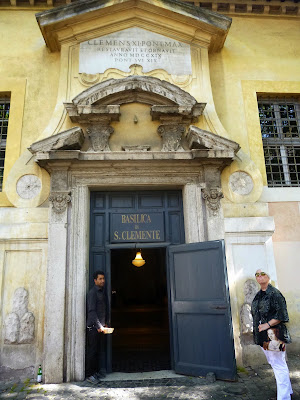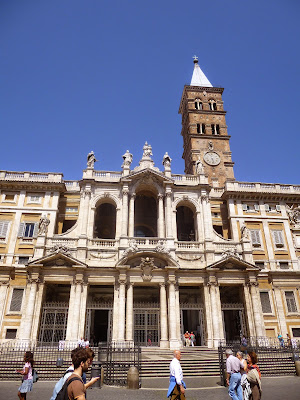 After another nice breakfast on the terrace, we depart for my last day in Rome.
After another nice breakfast on the terrace, we depart for my last day in Rome.
 We take a tram to S. Giovanni in Laterano, passing close to the Colosseum.
We take a tram to S. Giovanni in Laterano, passing close to the Colosseum.Our aim is to visit the astonishing archaeological site in the Basilica di San Clemente and discover 2000 years of history.
The Basilica and ex-convent of San Clemente is situated some three hundred yards above the Colosseum, on a road that rises gradually to St John Lateran from the valley between the Coelian Hill on the south and the Oppian Hill on the north.

It is named after Pope St
Clement, the third successor of St Peter in the See of Rome, who died about 100
A.D.
In 1857, Fr Joseph
Mullooly, the then Prior of San Clemente, began excavations under the present
basilica, uncovering in the process not only the original, fourth- century
basilica directly underneath, but also at a still lower level, the remains of
an earlier, first-century building.
Later excavations, notably those conducted
in 1912-1914 by Fr Louis Nolan when a drain was being built between San
Clemente and the Colosseum, showed that underneath this third layer of
buildings there was still a fourth stratum, that containing buildings
destroyed in the fire of Nero in 64 A.D.
The level, therefore, of the
valley in which San Clemente lies was about sixty feet lower in the first century
than the present level.
After the fire of 64 the gutted buildings were filled
in and used as foundations for further houses, at a level that is roughly that
of the floor of the Colosseum today.
 At this
third level at San Clemente there are two buildings that are separated from
each other by a narrow passageway. The less pretentious of these is a brick
building, possibly an « insula » or apartment house, in the courtyard of which
there is a small Mithraic temple of the end of the second century.
At this
third level at San Clemente there are two buildings that are separated from
each other by a narrow passageway. The less pretentious of these is a brick
building, possibly an « insula » or apartment house, in the courtyard of which
there is a small Mithraic temple of the end of the second century. The church has a beautiful interior, but it is especially notable for its three historical layers. The 12th-century basilica is built on top of a well-preserved 4th-century church (with many frescoes), which was built next to a 3rd-century Mithraic Temple.
The church has a beautiful interior, but it is especially notable for its three historical layers. The 12th-century basilica is built on top of a well-preserved 4th-century church (with many frescoes), which was built next to a 3rd-century Mithraic Temple.  The 3rd-century Temple of Mithras, down a narrow corridor to the left, was deliberately destroyed when the church was built, but one room has survived. It is a small artificial cave with stars on the ceiling, long side benches, and a stone altar with a relief of Mithras slaying the bull.
The 3rd-century Temple of Mithras, down a narrow corridor to the left, was deliberately destroyed when the church was built, but one room has survived. It is a small artificial cave with stars on the ceiling, long side benches, and a stone altar with a relief of Mithras slaying the bull.
 |
| 11th/12th-century fresco of St. Clement and the legend of Sisinnius. |


 |
| 9th-century fresco of the Ascension of Christ |




 |
| East entrance of Santa Prassede, as seen from the main road (Via Merulana) that leads to Santa Maria Maggiore. |
 A hidden gem just steps away from Santa Maria Maggiore,
Santa Prassede is a 9th-century basilica with glorious Byzantine mosaics
in the apse and filling a side chapel.
A hidden gem just steps away from Santa Maria Maggiore,
Santa Prassede is a 9th-century basilica with glorious Byzantine mosaics
in the apse and filling a side chapel.
The church of Santa Prassede is dedicated to St.
Prassede (or Praxedes), the sister of St. Pudenziana and daughter of
Pudens, in whose house St. Peter reportedly stayed while in Rome.
The current church dates from the early 9th
century. Pope Paschal I (817-824) erected this basilica to replace the
decaying 5th-century church and to house the neglected remains of saints that
he had removed from the abandoned catacombs. He also included a funerary chapel
for his mother Theodora.


 |
Chapel of St. Zeno, covered in 9th-century mosaics commissioned by Pope Paschal I.
|
 The most impressive feature of Santa Prassede by far are its mosaics, which cover the apse, the triumphal arch and the entire interior of the Chapel of St. Zeno. All are original to the 9th-centurybasilica. They are made almost exclusively of fine glass tesserae, which may have been taken from earlier mosaics.
The most impressive feature of Santa Prassede by far are its mosaics, which cover the apse, the triumphal arch and the entire interior of the Chapel of St. Zeno. All are original to the 9th-centurybasilica. They are made almost exclusively of fine glass tesserae, which may have been taken from earlier mosaics.
We reach the Piazza Santa Maria Maggiore
 |
| Esquilino obelisk |
At the basilica of Santa Maria Maggiore, a monolith of granite of 14.75 metres high (25.53 with stand and the cross), was erected. It is which is without hieroglyphics it lay in pieces next to the ruins of the mausoleum of Augustus and is paired today with the obelisk on the Quirinale (most likely they were taken from Egypt during the reign of Domitian).
Founded in the 4th century, the Basilica di Santa Maria Maggiore (Basilica of Saint Mary Major) is one of the five great ancient basilicas of Rome. Its 18th-century exterior conceals one of the best-preserved Byzantine interiors in the city.

Santa Maria Maggiore stands on the site of a temple to the goddess Cybele. According to a 13th-century legend, the first church was built here by Pope Liberius (352-66), on the site of an apparition of the Blessed Virgin Mary. The legend has it that the Virgin appeared to Pope Liberius and the patrician Giovanni Patrizio on August 4, 352 (or 358), instructing them to build a church on the Esquiline Hill. That night, the floor plan was outlined by a miraculous snowfall.
 Another highlight in the basilica is the beautiful coffered ceiling designed by Giuliano da Sangallo and created in the sixteenth century.
Another highlight in the basilica is the beautiful coffered ceiling designed by Giuliano da Sangallo and created in the sixteenth century. It is said to be gilded of gold that was brought from the Americas by Christopher Columbus and presented to pope Alexander VI by the Spanish king.
 The apse mosaic, depicting the Coronation of the Virgin, is from the late 13th century, by Franciscan friar, Jacopo Torriti.
The apse mosaic, depicting the Coronation of the Virgin, is from the late 13th century, by Franciscan friar, Jacopo Torriti.  Beneath the altar is a confessio with a kneeling statue of Pope Pius IX.
Beneath the altar is a confessio with a kneeling statue of Pope Pius IX. Beneath this, St. Jerome (d.420), Doctor of the Church and author of the Latin translation of the Bible, is buried in the Bethlehem crypt. The crypt is built to resemble the cave of the Nativity in Bethlehem.
We return home by taxi for a last quick lunch, after which I depart by train to the airport.
 |
| Goodbye to Deborah, in front of her apartment (top left with the terrace) |
The chaos at the other terminals is tremendous with lots of flights cancelled or delayed.
All ends well for the Brussels Airlines passengers, as the flight eventually depart from Terminal 1 and takes off with only 1 hour delay.
I finally arrive back in Bruges by 11 pm.






















